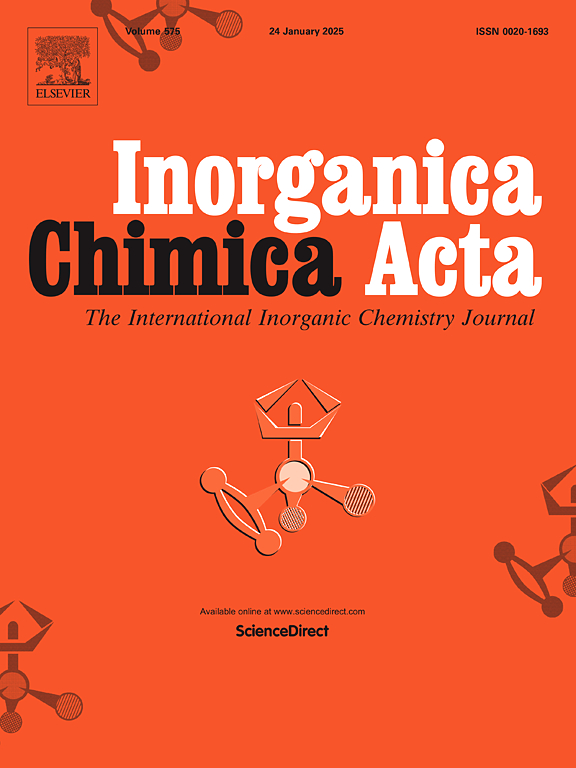异金属八面体簇[Re6-nOsnSe8Br6](4-n) - (n = 1,2):非同价金属取代对氧化电位的系统改变
IF 3.2
3区 化学
Q2 CHEMISTRY, INORGANIC & NUCLEAR
引用次数: 0
摘要
合成并研究了基于新型异金属簇阴离子[re5os2se8br6]3−和[Re4Os2Se8Br6]2−的化合物。对这些阴离子Cs+和Bu4N+盐晶体结构的研究表明,溴离子[Re6-nOsnSe8Br6]、氯离子[Re6-nOsnSe8Cl6]和同金属簇[Re6Se8Br6]在结构上具有相似性。利用量子化学DFT计算表明,{Re5Os}3+和{Re4Os2}4+金属中心的几何形状接近于未扭曲的八面体。我们还发现,铼原子被锇原子非同价取代导致团簇的最高已占分子轨道(HOMOs)稳定约0.7 eV / Os原子。这种效应被循环伏安法实验证实:新阴离子的氧化电位相对于同金属簇[Re6Se8Br6]4−有很强的阳极位移。本文章由计算机程序翻译,如有差异,请以英文原文为准。
– (n = 1, 2): systematic change of the oxidation potential by non-isovalent metal substitution](https://img.booksci.cn/booksciimg/2025-7/102305618311783566959.jpg)
Heterometallic octahedral clusters [Re6-nOsnSe8Br6](4-n)– (n = 1, 2): systematic change of the oxidation potential by non-isovalent metal substitution
Compounds based on new heterometallic cluster anions [Re5OsSe8Br6]3− and [Re4Os2Se8Br6]2− were synthesized and investigated. The study of the crystal structure of the Cs+ and Bu4N+ salts of these anions showed structural similarity between bromide [Re6-nOsnSe8Br6], chloride [Re6-nOsnSe8Cl6] anions and homometallic cluster [Re6Se8Br6]. Using quantum-chemical DFT calculations, it was shown that the geometry of the {Re5Os}3+ and {Re4Os2}4+ metal centers is close to an undistorted octahedron. It has been also found that the non-isovalent substitution of rhenium atoms by osmium resulted in the stabilization of the cluster's highest occupied molecular orbitals (HOMOs) by about 0.7 eV per Os atom. This effect was confirmed experimentally by cyclic voltammetry: a strong anodic shift of the oxidation potential of the new anions with respect to the homometallic cluster [Re6Se8Br6]4− was demonstrated.
求助全文
通过发布文献求助,成功后即可免费获取论文全文。
去求助
来源期刊

Inorganica Chimica Acta
化学-无机化学与核化学
CiteScore
6.00
自引率
3.60%
发文量
440
审稿时长
35 days
期刊介绍:
Inorganica Chimica Acta is an established international forum for all aspects of advanced Inorganic Chemistry. Original papers of high scientific level and interest are published in the form of Articles and Reviews.
Topics covered include:
• chemistry of the main group elements and the d- and f-block metals, including the synthesis, characterization and reactivity of coordination, organometallic, biomimetic, supramolecular coordination compounds, including associated computational studies;
• synthesis, physico-chemical properties, applications of molecule-based nano-scaled clusters and nanomaterials designed using the principles of coordination chemistry, as well as coordination polymers (CPs), metal-organic frameworks (MOFs), metal-organic polyhedra (MPOs);
• reaction mechanisms and physico-chemical investigations computational studies of metalloenzymes and their models;
• applications of inorganic compounds, metallodrugs and molecule-based materials.
Papers composed primarily of structural reports will typically not be considered for publication.
 求助内容:
求助内容: 应助结果提醒方式:
应助结果提醒方式:


